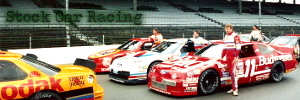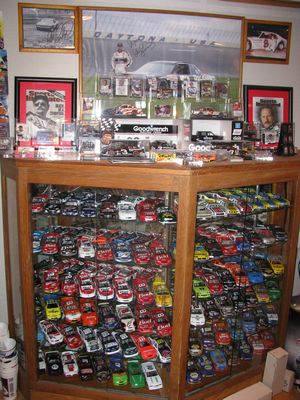















Random Lugnuts: Zombie Sponsorships |
|---|
 What is Random Lugnuts? It's random bits of stock car racing commentary written on an irregular basis by an irregular racing fan. The name is a reference to the lugnuts that go flying off a car during a pit stop: you never know where they are going to go, what they're going to do when they get there, they can be annoying, they're often useless after a race, and every once in a while someone gets hit and they don't know exactly where it came from.
What is Random Lugnuts? It's random bits of stock car racing commentary written on an irregular basis by an irregular racing fan. The name is a reference to the lugnuts that go flying off a car during a pit stop: you never know where they are going to go, what they're going to do when they get there, they can be annoying, they're often useless after a race, and every once in a while someone gets hit and they don't know exactly where it came from.
Opinions expressed by Bill Crittenden are not official policies or positions of The Crittenden Automotive Library. You can read more about the Library's goals, mission, policies, and operations on the About Us page.
|
Bill Crittenden
November 14, 2009
This is the third part of a three-part article. The first part was NASCAR Teams and Sponsorship Money and the second part was Beyond the Hood.
One of the best features of sponsoring a NASCAR race car is that the sponsorship has the potential to provide a return on investment long after the investment has been paid for. In a few cases, even decades after the initial investment. What do I mean by this? In a previous article, Beyond the Hood, I mentioned a lot of different places, aside from the hood of the car itself, where images of sponsor logos can be seen away from the track. While that car, and its hood, can come back to the track after the offseason sporting new colors and new brands (or end up in the scrap heap), a lot of the images of that car survive.
Like the walking undead, old NASCAR sponsorships don't have any real life to them. The sponsor's former driver is wearing new colors and plugging new brands, and they won't show up to any more personal appearances or allow their name to be used in any new promotions. But they're not buried yet, seen on the backs and heads of fans wearing last season's swag, popping up in basement car collections and occasionally making their way into TV broadcasts.
Think about this: the average fan doesn't just crap can all their stuff when their favorite driver changes sponsors, they just add more to their collections. All that die cast, all those posters, all those t-shirts and hats, they usually stay on display or get worn for years after they're out of date. My neighbor, whom I wrote about in NASCAR Teams and Sponsorship Money, didn't just dump all his Budweiser stuff when Dale Jr. switched teams (and sponsors), he just went out and bought the pair of new die cast cars (Amp and National Guard) and put them on display alongside the old Bud cars.
 |
NASCAR die cast display
Think about how old some of the company logos are in this picture...and they're still on display! Photo ©2009 Bill Crittenden View photo, 4,934KB |
In a sport as conscious of history as NASCAR is, the legends of the past are getting a lot of TV time in the present. Whether it's Richard Petty's famous Petty Blue 43 at Daytona or the ominous black Chevrolet that helped Dale Earnhardt look the part of "The Intimidator" and inspired the name "The Man in Black," images of past stars and past races keep putting old cars in front of the eyes of fans that in some cases weren't even born before the sponsorships ended. And when NASCAR broadcasts drag out the old Petty clips or Earnhardt videos, STP and GM Goodwrench make it back on the air, long after these companies stopped spending money as primary sponsors for Cup race teams.
These returns on the sponsorship investments aren't guaranteed any more than they are when a sponsorship is new. They are, perhaps, even harder to accomplish, as an attention-getting young star this year might be a forgotten flameout in five more. A sponsor's longevity is then dependent upon the longevity of the driver's popularity and to an extent the achievements made in the car. Much like syndicated television, most one- or two-season flops fade into obscurity, while a select few drivers (and by extension, their sponsors) stay on television long after their sponsorships, their careers, and even their lives, have ended. For every legend there are hundreds of short, forgotten careers, and by extension forgotten sponsors.
Of course, there are only a realtive handful of true legends to go around in NASCAR, but for a lucky few sponsors sometimes all it takes is one spectacular moment to etch an image into the history books of stock car racing and keep a sponsor's image on television for years. One of the greatest examples of this is Ricky Craven and Tide. Ricky's certainly not a legend on par with Petty or Earnhardt, but his Darlington win is a classic, and every year when the Cup series visits the track or when the commentators discuss a really close finish, we get replays of the last laps of his win, ending with Ricky putting the nose of his Tide Pontiac across the line just in front of Kurt Busch's Rubbermaid Ford. Rubbermaid and Tide haven't been primary sponsors on Cup cars in years yet we see the cars, sponsors and all, at least a few times every year. I assume we will continue to do so for the foreseeable future, at least until another pair of drivers sets a new record for closest finish.
An honorable mention in this category is the 1979 Daytona 500. Not a February goes by when I don't see clips the famous fistfight between Donnie Allison and Cale Yarborough at the end of the race, Yarborough's Busch and Allison's Hawaiian Tropic logos visible as the cars tangle before heading into the wall. Of course, Allison and Yarborough are remembered for other achievements in the sport, but this clip is a SpeedWeeks staple, and also illustrative of the point since Yarborough's sponsor wasn't one that had been on the side of his car through his three championships. But do these "zombie sponsorships" really move product? In the absence of statistics, I offer the following anecdote: you don't see very many green cars in NASCAR, especially green cars sporting a particular #3, and so Dale Jr.'s old Sun Drop car stood out amongst the many die cast cars that I've seen. So one day, oh, about ten years or so after the late-model Lumina raced, and shortly after Action replicated the car in 1:24th scale, I was strolling through Woodman's grocery in Kenosha and notice a case of the stuff. A case of soda I'd have otherwise passed by without a second glance had not only caught my attention but had me curious to try it, and I bought it. Over a decade after Sun Drop likely cut its last check for the sponsorship and people were still buying die cast cars with painted up with Sun Drop logos, and those cars were the reason I had not only heard of the brand but then decided to buy a case of their product. And now, another half decade after I bought my first case, I still do buy it when I can find it.
Interestingly, some the sponsorship images stick around even after the company that sponsored the car is gone! Anyone remember The Family Channel? :Technically still on the air as ABC Family, the old name disappeared eleven years ago, yet The Family Channel is a name still seen in my basement. Why? Because I like Ted Musgrave, and it was an epically cool paint scheme. Telecommunications companies have been especially prone to have their logos stick around longer than their companies, due to an enormous amount of investment followed by a period of mergers as new technologies and new services worked themselves out economically. Do you remember 10-10-220, which of course is remembered because they sponsored an Earnhardt? What about Alltel, Cingular, and (not that it was a car sponsor) Nextel?
What got me started thinking about sponsorships was the return of the number 3 to top-level NASCAR competition on the side of Austin Dillon's truck. Alongside the famous 3 was the name Bad Boy Mowers. I wondered if this lawnmower manufacurer realized at the time that for sponsoring a part-time kid that they would not only get repeated exposure on news websites and on television beyond what any other truck in the race would receive (including the winner), or that their truck in NASCAR's third-highest series would be a hotter topic for the week than most anything happening in the Cup series, or that they would be permanently along for the ride as that truck is now a small piece of NASCAR history as an afterword in the story of Dale Earnhardt.
